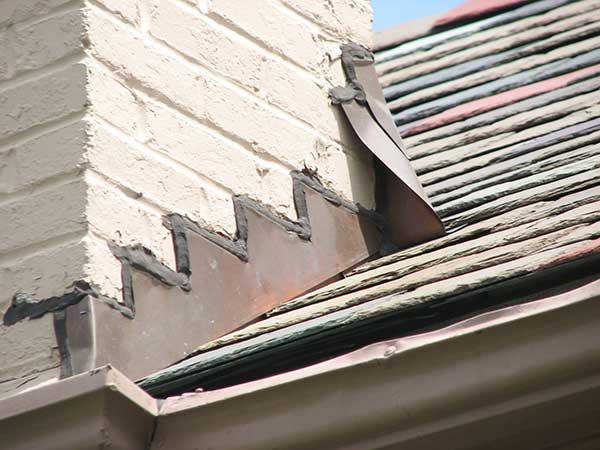We Provide Reliable Chimney Flashing Repair Services
Our homes are built to be strong, durable, and long-lasting. It can be hard to believe that something like exposure to water could end up causing major damage. Unfortunately, moisture is one of the worst things your chimney and home can come into contact with, which is why investing in preventive measures is a must.
When it comes to preventing water entry, flashing plays a big role in protecting your home from a leaky chimney or ceiling. And due to its location on the roof, you might not be aware that you need your flashing replaced until it’s time for your annual chimney inspection or there’s a leak or other noticeable evidence of water damage.
If you need flashing repair services, you can trust English Sweep to protect your chimney from water. Call us for an appointment at 636-225-3340 or get in touch with us online.
What Is Chimney Flashing?
Not totally clear on what flashing is? No worries – that’s what we’re here for. An informed customer is a safer and more empowered customer, so we’re happy to keep you knowledgeable and up to date on all things chimney-related.
Your flashing is the waterproof metal seal that covers the area where your roof and chimney meet up. Both your roof and chimney expand and contract based on a number of factors, and because they’re made from different materials, they don’t do this in sync. These movements are so slight that you may think it’s no big deal, but they create the perfect opportunity for water to enter.
That said, if properly installed flashing is in place, water won’t stand a chance of breaking in. It’ll simply roll off your flashing and down your roof, keeping your chimney system and home dry and protected.
Chimney flashing is made up of a few parts:
- Base (or Step) Flashing: Base flashing is applied to the vulnerable area where the roof and chimney meet, and it is composed of a series of pieces that look a bit like steps.
- Counter Flashing: Counter flashing is installed over the base flashing to offer another layer of protection against water entry. It helps to seal the top of the base flashing and is then embedded into the mortar joints of the chimney to hold it secure.
- Saddle Flashing (when applicable): Depending on the width of your chimney, it may need saddle flashing (also known as a cricket). This is a peak built beside the chimney to ensure water can effectively flow off and doesn’t end up pooling on one side.
What Materials Can Be Used for Chimney Flashing?
There are several options available to homeowners when deciding on what type of material is best for their flashing. Some choices offer durability and long-lasting protection, while others are more customizable and easier to install. These are some materials you can select from:
Aluminum:
Aluminum flashing is lightweight and corrosion-resistant. It’s easy to install and can be painted to match the roof or chimney.
Galvanized Steel:
Galvanized steel is durable and cost-effective. It’s a popular choice for homeowners in regions with more extreme weather conditions.
Copper:
Copper is a high-end option that offers great corrosion resistance and can develop an attractive patina finish over time. It’s often chosen for its curb appeal.
EPDM Rubber:
Ethylene Propylene Diene Monomer (EPDM) rubber is a flexible and durable synthetic material that can be used for flashing. It is often preferred in situations where other materials might not work as well.
Vinyl or PVC:
Vinyl and Polyvinyl Chloride (PVC) flashing is cost-effective and easy to work with. It is resistant to corrosion and available in various colors. It should only be used in warmer climates as it can crack under extreme weather conditions.
Zinc:
Zinc flashing is another durable and corrosion-resistant material. It is often used in conjunction with standing seam metal roofs.
How To Know if Your Flashing Needs Repairs
Many homeowners ask if there are any obvious signs of flashing damage that they can watch out for.
- First off, keep an eye out for any leaks. There are lots of reasons your chimney might be leaking, but damaged flashing is often a contributor to this.
- Noticing water stains on the walls and ceiling surrounding your chimney? This is another clear-cut sign that your flashing isn’t doing its job.
- You should also watch for rust on the flashing itself. Rust typically means water is pooling up and sitting on your flashing, which will cause the metal to deteriorate well before it should.
- Any of the classic signs of water-related damage could indicate that your flashing is failing, so be on the lookout for damaged brickwork, missing mortar joints, rotted woodwork, mold growth, and any other indicators of water invasion.
If any area of your chimney system is looking worrisome, give us a call or reach out to us online. We’re happy to help.
Do I Need To Install a Roof Cricket?
If your chimney is wider than 30 inches, it’s a good idea to ask your chimney technician about the benefits of installing a roof cricket. Also known as saddle flashing, a roof cricket prevents water from pooling at the base of your chimney. When water collects around this area, it seeps into the brick and gradually breaks it down. Some other considerations to speak to your chimney technician about:
- Roof Slope: Water runoff can be slower on roofs with a low slope which increases the likelihood of water pooling around chimneys, skylights, or other vulnerable areas. Steeper roofs tend to shed water more effectively, and you are unlikely to be a good candidate for a roof cricket.
- Local Building Codes: Some towns and cities mandate the installation of roof crickets if you have specific roofing materials. Check your local building codes and regulations.
- Roofing Material: The type of roofing material you have may influence the need for a cricket. Some materials, like metal roofing, are better at shedding water quickly. Others, like asphalt shingles, may need more reinforcements in the fight against water infiltration.
Why DIY Chimney Flashing Repairs Isn’t the Right Choice
We get the appeal of do-it-yourself projects. If you’re known for being handy, it may seem like a good option to tackle flashing repairs or installation yourself – and in this day and age, finding steps for doing so online isn’t a problem.
We strongly advise against this, both for your safety and the health of your chimney.
If the appropriate materials aren’t used and the job isn’t done just right, you simply won’t get the results you need, and your chimney will face damage. You might be saving money now by doing it yourself, but chances are, you’ll end up needing costly repairs down the line. Avoid the cost and headache by having the job done by an experienced pro.
Not only will a pro know exactly what products to use and how to offer the greatest protection, but they’ll also know how to safely do the job. Working on this part of your roof is dangerous. If you aren’t well-versed on how to navigate the spot, a slip or fall could easily occur. And if you don’t have the necessary safety equipment or harnesses, you’ll likely be adding some doctor bills onto your project budget. Not worth it.
Ready to trust our experts? We’re here for you. Call or schedule with us online today.
Who Can Install or Replace Chimney Flashing?
If not you, then who? It’s a fair question. For flashing repairs (and all chimney work), you should hire a company with a reputation for customer satisfaction and with chimney technicians that have been certified by the Chimney Safety Institute of America (CSIA) and are members of the National Chimney Sweep Guild (NCSG).
For residents in and around St. Louis, English Sweep is here to help you. We have a long history of providing excellent customer service and top-rated installation and repair work for clients throughout the area. Chimney flashing is just one step in protecting your chimney from moisture. You can trust us with all of your waterproofing needs!
Need Flashing Installed or Repaired? Call Us Today
Don’t leave your chimney unprotected. Get in touch with us now to schedule an appointment to have your chimney installed or repaired. Water getting into your chimney may not seem like it should be a huge concern, but it can lead to expensive and time-consuming repairs. Book an appointment through our website or call us at 636-225-3340. We’ll get the job done right!
Installing the right chimney cap could be the simple solution to fixing your chimney leak.

